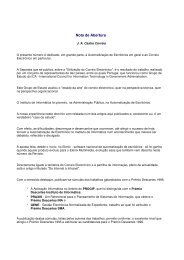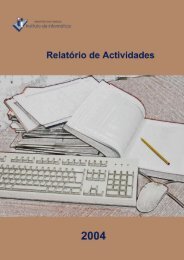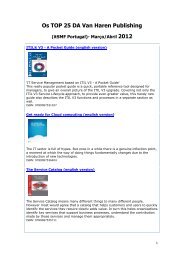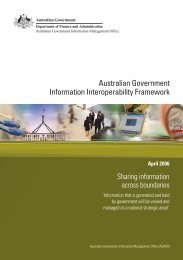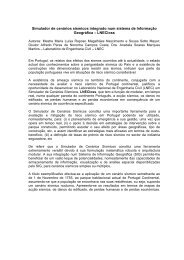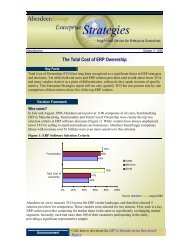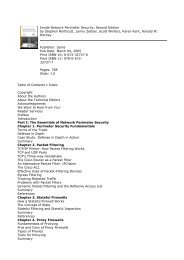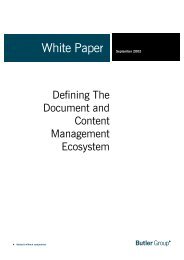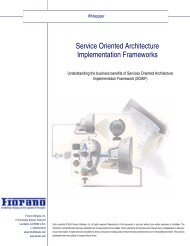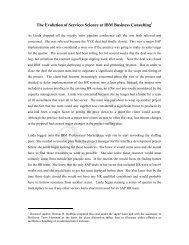OECD Peer Review of E-Government in Denmark - ePractice.eu
OECD Peer Review of E-Government in Denmark - ePractice.eu
OECD Peer Review of E-Government in Denmark - ePractice.eu
Create successful ePaper yourself
Turn your PDF publications into a flip-book with our unique Google optimized e-Paper software.
Source: <strong>OECD</strong> E-<strong>Government</strong> Survey: <strong>Denmark</strong>.<br />
Legislative and regulatory environment<br />
The Danish legal system provides a framework for enabl<strong>in</strong>g digital communications both with<strong>in</strong><br />
and across government that is appropriately supportive <strong>of</strong> e-government. This is the result <strong>of</strong> new<br />
legislation enabl<strong>in</strong>g e-government processes (i.e. the Act on Electronic Signatures) and efforts to<br />
simplify and modernise exist<strong>in</strong>g Danish legislation, with a focus on ensur<strong>in</strong>g that legislation is<br />
compatible with digital communication.<br />
The <strong>in</strong>itiative to enable e-government through legislative simplification was part <strong>of</strong> the overall<br />
Rule Simplification Programme, launched by the M<strong>in</strong>istry <strong>of</strong> F<strong>in</strong>ance <strong>in</strong> 2002 as a key component <strong>of</strong><br />
the <strong>Government</strong>’s programme to modernise the public sector and reduce the adm<strong>in</strong>istrative and<br />
regulatory burden it imposes on citizens and bus<strong>in</strong>esses. The goal <strong>of</strong> this work was to promote digital<br />
communication by elim<strong>in</strong>at<strong>in</strong>g legal barriers to both e-government and e-commerce. The <strong>Government</strong><br />
was committed to implement<strong>in</strong>g any new laws or legislative amendments that might be required by<br />
early 2003.<br />
The <strong>in</strong>itiative required all Danish m<strong>in</strong>istries to review their legislation and regulations to locate<br />
provisions that constra<strong>in</strong>ed digital communication between public authorities, citizens and bus<strong>in</strong>esses.<br />
Where these were identified, m<strong>in</strong>istries looked at the reasons beh<strong>in</strong>d their existence and assessed<br />
whether or not they could, or should, be changed. M<strong>in</strong>istries then used this analysis to develop action<br />
plans for the modernisation <strong>of</strong> legislation. A secretariat consist<strong>in</strong>g <strong>of</strong> the M<strong>in</strong>istry <strong>of</strong> F<strong>in</strong>ance, the<br />
M<strong>in</strong>istry <strong>of</strong> Justice and the M<strong>in</strong>istry <strong>of</strong> Science, Technology and Innovation provided guidance as<br />
required, and followed up on the implementation <strong>of</strong> m<strong>in</strong>istries’ action plans. The secretariats to the<br />
State IT Council and the Jo<strong>in</strong>t Board <strong>of</strong> e-<strong>Government</strong> also had roles <strong>in</strong> co-ord<strong>in</strong>at<strong>in</strong>g the work.<br />
In June 2004, the Danish Digital Task Force took over responsibility for f<strong>in</strong>ish<strong>in</strong>g the project and<br />
produc<strong>in</strong>g a f<strong>in</strong>al report on the work that had been undertaken. The document, based on m<strong>in</strong>istries’<br />
status reports on the implementation <strong>of</strong> their action plans, was seen as the f<strong>in</strong>al step <strong>in</strong> the legislative<br />
modernisation programme.<br />
As reported by the Task Force, the outcome <strong>of</strong> the project was that 423 laws or regulations<br />
present<strong>in</strong>g unnecessary barriers to e-government have been amended, or will be <strong>in</strong> the near future.<br />
However, the process also identified another 1,106 laws and regulations that were considered<br />
impossible to amend, either because they are tied to specific documents (such as passports, drivers<br />
licences, etc.) requir<strong>in</strong>g non-digital procedures to fulfil pro<strong>of</strong> functions, or because they are tied to EU<br />
rules or <strong>in</strong>ternational conventions that prescribe non-digital procedures.<br />
Despite the fact that many laws and regulations have not been updated, the modernisation process<br />
appears to have had the desired overall effect <strong>of</strong> remov<strong>in</strong>g legal impediments to e-government<br />
wherever possible. While the <strong>OECD</strong> survey did not directly <strong>in</strong>vestigate the impact <strong>of</strong> legislative and<br />
regulatory modernisation on e-government implementation, it does show that a relatively limited<br />
number <strong>of</strong> respondents regard conflict<strong>in</strong>g or <strong>in</strong>consistent regulations as important barriers to<br />
e-government.<br />
<strong>Denmark</strong> has also enacted legislation enabl<strong>in</strong>g the use <strong>of</strong> digital signatures. The Danish Act on<br />
Electronic Signatures came <strong>in</strong>to force on 1 October 2000. Adm<strong>in</strong>istered by the M<strong>in</strong>istry <strong>of</strong> Science,<br />
Technology and Innovation, the Act implements EU Directive 1999/93 <strong>of</strong> 13 December 1999. Its<br />
purpose is to promote secure and efficient use <strong>of</strong> electronic communication, and to ensure that Danish<br />
electronic signature products and certification authorities meet a number <strong>of</strong> requirements – <strong>in</strong>clud<strong>in</strong>g<br />
42



